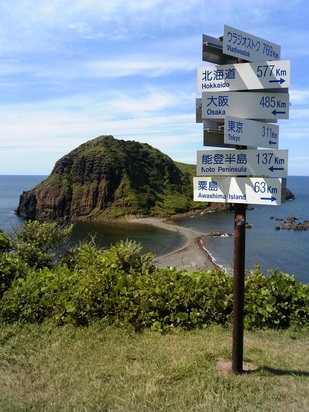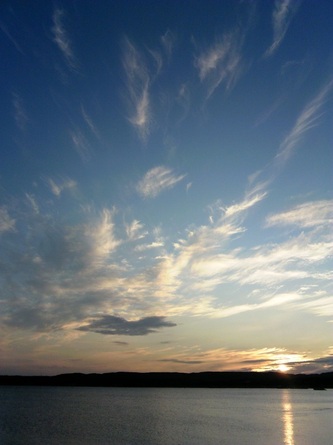After the morning commute, there is a period of about four hours during which most of the buses on Sado are idle, so sleeping late rather scuppered my plans for sightseeing. After studying the timetable in some detail, I decided to head for Futatsugamé at the far north-eastern tip of the island (seen from above, Sado is shaped like a kind of laterally elongated figure of eight, with four corresponding ‘corners’), and after catching the bus from Sawata to Ryotsu, had to wait two hours for the bus along the coast towards Iwayaguchi. Not only that, but the last bus back from Futatsugamé to Ryotsu departed at 2.30, which meant a ratio of five and a half hours’ travelling to just one hour of sightseeing.
It was well worth the trouble, though, as Futatsugamé – not to mention the scenery along the way – was enchanting. The further along the coast we travelled, the narrower and more circuitous Route 45 became, and at Futatsugamé itself, there was a hotel, a campsite and very little else. From the bus stop, a path led down through the trees, and arriving at a headland at the far end of the campsite, this was the view – and the sign – that greeted me.

Based on its double-hump-backed profile, the name Futatsugamé (二ッ亀) means ‘two turtles’, and particularly on such a fine, still day, the narrow sand bar leading out to an idyllic island looked positively heavenly: like those metaphorical depictions of the afterlife in which one crosses over from the real world to an ethereal paradise. A few fellow tourists were relaxing on the beach or swimming in the sea, but I just sat in the shade of a tree and took a few photos, before climbing back up to the hotel, buying a drink from a vending machine and getting back on the bus.
Sitting across the aisle from me was Johannes, who I recognised as the same person that saved me from heading the wrong way out of Aikawa the previous afternoon. Johannes was gangly and almost hippy-ish, with thick-framed spectacles, a bandana and a long, frizzy ponytail. Originally from the old East Germany, he now lived in Kyushu and earned his living as a freelance writer.
‘This may sound like a stupid question, but what language do write in?’ I asked him.
‘English,’ he said. ‘I went to university in America and I used to show experimental films in a kind of road show. We travelled all over the place and I ended up writing a book about it. I had a proper job before I came to Japan, but now I write full time – I’m about to have a book published about North Korean cinema.’
‘I didn’t even know there was such a thing.’
‘That’s partly why came to Sado, to interview Charles Jenkins. He starred in a few North Korean films after he defected.’
‘You mean propaganda films?’
‘They were proper feature films, although he was always cast as the evil western bad guy. North Korea was part of a group of what used to call themselves “non-aligned” nations – they all made really boring films and showed them at each other’s festivals. I went to a festival in North Korea myself recently, although even now the western films they show are very “safe”.’
Johannes often writes about Japan for japanvisitor.com (you can find a brief biography and a selection of his other articles here), and with the eye of a true travel writer, as the bus wended its way back along the coast, he spotted a village with the intriguing name of Kuro-himé (黒姫 / Black Princess – purely out of curiosity, I later Googled the name and found out that in 1651, Kuro-himé had an official population of just six people, and even now is reputedly home to various ghosts and goblins). Back at Ryotsu, Johannes wished me luck with my own writing and went to catch the ferry to the mainland, while I waited for yet another bus to Sawata.
In keeping with my remedial grasp of mathematics, I had only just realised that I had five rather than four more days in which to make it back to Ibaraki (I left on the 21st and had to return on the 31st, which means ten days, right? Wrong!). Reasoning that it would be nice to have a day off before going back to work on 1st September, I booked in for just one more night at the campsite, and while I didn’t realise it at the time, this would prove to be a very wise decision indeed.

I was at the izakaya by eight o’clock as planned, and by way of indicating that I was the guest of honour, O-san me at the end of the bar and to his left, which was flattering but at the same time less than ideal, as it placed me downwind from an almost continuous fog of cigarette smoke (O-san was one of those chain smokers who is so anxious to start their next cigarette that they stub the previous one out when it is only half-finished). Presently we were joined not just by S-san, who sat at the opposite end of the bar, but by another S-san – let’s call him S-san II – who as O-san’s junior and S-san I’s superior, sat between the two of them.
S-san II was in his late forties or early fifties and what you might call well-groomed: he had a suspiciously flawless tan, his hair was dyed black and permed into a kind of semi-bouffant, and when he was pouring a drink he had the ladylike habit of extending his little finger away from the bottle. When he talked, though, I couldn’t help but be reminded of Finchy from The Office: the nightmare sales rep and unreconstructed MCP.
‘I was out drinking the night before last,’ said S-san II, ‘and we ended up at a karaoké place with these girls. I can’t remember much after the first couple of songs because we were so drunk, but on the way back to the hotel I fell into a bloody rice field! My suit was absolutely covered in mud – I had to wash it in the bath – and I had my laptop with me as well. Lucky I didn’t drop that too.’
When S-san II found out that I was from England, he told me about a homestay trip during his student days.
‘I stayed with a family in Bournemouth,’ he said. ‘The worst thing was the hot water – you had to wait for it to heat up!’
‘I should think it was good for your English, though.’
‘Sort of. I could understand the children I was staying with, but I had no idea what their parents were talking about at all. A group of us hired a car and drove up to London – we went to that place…what was it called? You know, the one with all the strip clubs.’
‘Soho.’
‘Yes, Soho! We drove to Edinburgh, too, and it wasn’t as far as I thought – only took us about five hours.’
Somehow I had the feeling S-san II didn’t go to Edinburgh for the architecture, and as the evening progressed, I was worried that the three of them might decide to introduce me to some of their hostess friends and keep me boozing until the early hours. As it turned out, though, they were tired after a long day at work, and at 10pm O-san paid the bill as promised, and left me with his business card and a promise that he would be in touch the next time he visited the Hitachi branch of his kimono company.
I thoroughly enjoyed this blog and created a Weebly account too.
Lovely sky photo!